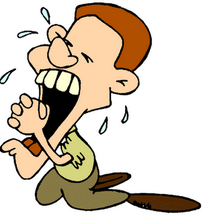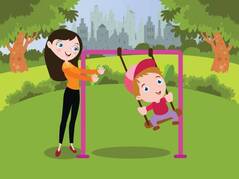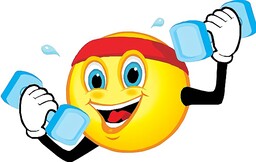 People talk a lot about the law of averages. By this they mean that if they do something enough times, there must be enough positive outcomes to balance out all the negative outcomes, to restore an average outcome at some imaginary point. This is a fallacy. It is also flawed thinking. Except in purely mathematical terms, there is no “law of averages”. For some things there are only ever negative outcomes or positive outcomes. There is no celestial balancing act between the two. The sheer number of variables in so many of life’s occurrences mean that no “average” could ever be achieved, because each one is essentially unique. People confuse the laws of statistical probability with the law of averages.  Statistical probability relies on things not changing between one occurrence and the next. If you toss a coin 100 times, for example, it should come down heads 50 times and tails 50 times. The amount of force used varies from coin toss to coin toss but, statistically there are only two possible outcomes, so the probability of one outcome vs the other is 50:50. But in most of life's occurrences, there are too many variables for statistical probability to give you a 50:50 outcome. In any occurrence the number of variables is sometimes so great that the number of possible outcomes is mind bogglingly large and there is no guarantee that any of those outcomes is going to be a positive one.  Gamblers work on a different fallacy with regard to "the law of averages". They believe that if something hasn’t happened for a while, (like the little white ball landing on certain number on a roulette wheel), then, by the “law of averages” it must happen very soon. However, where the ball lands on a roulette wheel is random (if the wheel isn’t rigged). The ball can just as easily land on the same number twice in succession as it can land on a number that it hasn’t landed on in a while. The ball hasn’t any will, so it can’t choose where it lands. The ball also has no memory, so it doesn’t know where it has landed and where it hasn’t (the same applies to lottery numbers). But the speed of the wheel, the way the croupier places the ball onto the wheel, and the point at which it is placed, are all variable, making each turn of the wheel unique.  Similarly, if a racehorse hasn’t won a race in a while, there is no reason to suppose it will win its next race. It isn’t winning races because it isn’t as fast as the other horses. It is not suddenly going to get faster, nor are the other horses suddenly going to get slower, just to satisfy some non-existent “law of averages”. A change of jockey or a change in trainer may result in the horse winning a race, but that has nothing to do with the “law of averages” because something has changed, therefore changing the likelihood of the outcome. It is the change that made the difference. Let me give you an extreme example. If you stick your hand in a fire, it will get burnt. That is a negative outcome. But there is no positive outcome. You cannot ask 100 people to stick their hand in a fire and get a negative outcome in the belief that the 101st person to do it won't get their hand burnt in order to satisfy the “law of averages”. I’ll give you another example, this time less extreme.  If a job applicant sends out their CV (resumé for our American readers) to 100 companies and gets no response, sending it out to another 100 companies does not mean that there will be a company that will decide to take a chance on the applicant, just so the “law of averages” can be balanced out by a good outcome. If a CV has been rejected 100 times, there must be something wrong with it because 100 companies are not going to reject a good candidate for a job. And so we get to the nub of this week’s blog.  When it comes to querying a book, there is also no law of averages. OK, not every agent that the MS is sent to will be the right agent for that book. A bit of research can eliminate those before the query is even sent. Also, some agents may not really be looking for new authors, so they will reject the MS and other agents may not read the submission properly and so will reject it because they didn’t “get it”. There may be other reasons why some agents reject an MS which have nothing to do with their literary merits. Who knows? But sending a query out time after time and getting the same result doesn’t mean that the law of averages says that on the next attempt you will hit the target with the right agent. If you get past a certain (unspecified) number of rejections, then it probably means that no one likes your MS and the time has come to stop sending out queries and start reviewing your MS to find out what is wrong with it. or to review your options for getting your book published. Or both. In other words, it’s not them, it’s you (or, rather, it’s your MS).  We see a lot of posts on social media with people saying they’ve sent out their MS again to another hundred agents, or direct to publishers, and this time they’re hoping for better results. If you have made over 20 queries the chance of finding an agent is actually getting smaller, not bigger because there is no law of averages. There is only an MS that agents/publishers like or one that they don’t like enough to take a chance with. Don’t take that number of 20 as being some sort of empirical threshold. It just feels about right to us. Maybe it’s 25, maybe 30, but we doubt that it’s much higher. Einstein defined insanity as doing the same thing over and over again and expecting different outcomes each time. He knew there was no such thing as a “law of averages”. So, are you displaying that sign of insanity?  In the world self-publishing this maxim also applies. If you have tried the same things time after time to sell your book and sales haven’t improved, there is only one of two conclusions you can draw. Your approach to marketing is wrong, or the book isn’t attracting readers for some other reason. If the marketing you are doing isn’t selling your book, then you have to try something new. If you always do what you always did, you’ll always get what you always got. If you want something different you have to do something different. And if you have tried something different and the book still isn’t selling, you have to look at the book itself and ask why readers aren’t attracted to it. Maybe it’s the cover image. Maybe it’s the blurb. Maybe it’s the “look inside” sample, or maybe it’s the reviews that have been posted. Maybe it’s something else entirely. But the thing it won’t be is the law of averages. If you have enjoyed this blog, or found it informative, then make sure you don’t miss future editions. Just click on the button below to sign up for our newsletter. We’ll even send you a free ebook for doing so.
0 Comments
 We see a lot of discussion on social media about which is best – traditional publishing (which we will abbreviate as TP) and self-publishing (abbreviated as SP). Within self-publishing we include small publishers such as ourselves, because we use most of the same channels for distribution and marketing as SP authors. We also see a lot of newbie authors asking whether they should go TP or SP before they have even written their book. We’ll circle back to that one later in the blog. The problem is that neither one nor the other is better in terms of choice. It may come as a surprise to budding authors, but you don’t get to make the choice. It may be your ambition to become a TP author, but agents and TP companies actually make the decision. Which means it’s their choice, not yours. All you can do is choose to try to become TP or choose not to bother but to go the SP route straight away.  Our advice would be always to try TP first. The reasons are quite obvious, but we’ll lay them out for you: 1. Access to wider distribution channels, especially major high street retailers. 2. Access to wider markets, such as overseas territories. 3. Professional support, especially editing and proofreading, but also cover design, blurb writing, translators etc. 4. Large marketing budget. 5. Marketing professionals selling your book for you. 6. Reputation and credibility (SP authors are often not regarded as “real” authors). To turn your back on all that would be foolish, so it is worth giving TP your best shot. But let’s do a reality check.  In the UK there are probably in excess of 50,000 working authors who haven’t got a TP contract already. That is a conservative estimate. The actual figures could be much higher because many aspiring authors don’t announce what they are doing. In the USA that figure is probably ten times as high. In the UK there are 9 big name publishing companies (by value of sales*) with an alliance of smaller publishers taking up the number 10 slot. In the American top 10 some of the same names also appear, along with some purely domestic publishers.  Each of those top 10 UK publishers will sign perhaps 100 new authors a year, 1,000 in total. So, that gives a 49 to 1 chance of any of those 50,000 authors getting a publishing contract. I wouldn’t bet on a horse at those odds and, remember, that’s a conservative estimate. There are a number of smaller publishers who deal in niche genres or markets, but they take on far fewer new authors each year, so they don’t really feature in our calculations. So, in the UK, for every 50 authors working today only 1 is likely to get a TP contract. That doesn’t mean you shouldn’t try. It just means you have to prepare yourself for rejection. And even if you do get a TP contract, you will probably receive a lot of rejections along the way so, again, you have to be prepared for them.  An author who finds an agent or publisher with their very first query us as rare as a unicorn. Querying a book is brutal. We know, because everyone employed by our company has tried it at some time. That leaves 49 authors out of 50 to go the SP route or not bother publishing at all. I’ve already listed what you get with a TP contract, so if you go SP you have to provide all those things for yourself and that gives you two more choices. 1. Pay other people to do those things for you, or 2. Learn how to do them for yourself. We made a conscious decision not to pay people to do things we can do for ourselves. If we don’t know how to do something, we will learn how to do it. It is always going to be cheaper in the long term to learn something, because you only have to pay once. If you pay someone else, you have to pay every time you want to do it. If you plan on writing a lot of books, then the costs will mount up and every penny spent means a penny that has to be earned back in sales. At the end of this blog we’ll direct you to a resource that provides free training in some essential skills, such as writing, proofreading, editing and marketing.  Time for another reality check. If you think that writing a book is hard, then you are going to be shocked at how hard it is to market the finished work. We have posted a lot of blogs on book marketing over the years and we are still seeing the same issues being discussed on social media. This means one of two thing. Either people haven’t read our blogs on the subject (or anyone else's blogs about it), or it means newbie authors don’t realise that SP also means SM (self-marketing). It doesn’t matter which publishing website you use (KDP is one but there are several others), after you have clicked on the “publish” button, the real work is only just starting.  Nobody is going to stumble on your book by accident. Once your family and friends have bought a copy of your book, sales will dry up if you aren’t doing any marketing. If you have chosen the right keywords when you published the book, it will turn up in searches, but it won’t be on the first page. It may not even make it as high as the 10th page. Books that turn up on the 1st page of search results get bought, which is why paid advertising is used: it gets your book onto the first page.  Some books that turn up on the 2nd page of results may get bought. Books that turn up on the 3rd page or more rarely sell any copies. So, you have to find the ways of getting your book in front of readers and that is what marketing is all about. And if the SP author doesn’t do the marketing, nobody else is going to do it for them unless they are paid to do it. Which is why we always recommend going the TP route first, because if you don’t try, you can never succeed. Now, I said we’d circle back to wannabe authors fretting over the best way to publish their books before they’ve even written the book.  It’s very simple. If you haven’t written the book, you haven’t got anything to publish, so there is no point in fretting about whether to try TP or go straight to SP. At the very best you are wasting time that could be spent writing and, at the very worst, worrying about that sort of thing could cause writer’s block and you’ll never get your story written anyway. The time to worry about getting your book published is when you actually have a book. Not a first draft. Not a second draft. But a book that is the very best version of itself and has been tested on beta readers and then improved again based on their feedback.  Once you have that, you can start to worry about going TP or SP and, if you are going TP, how to go about finding an agent, because very few TP companies accept direct submissions and the ones that do aren’t in the top 10. If your beta readers are telling you that the book isn’t that great, then trying to go either route probably isn’t worth your while. Sadly, not everyone who wants to be an author has to the talent to become one. But that doesn’t apply to you, of course. And, finally, just to clear something up. If you have written a book you are a real author. Being an author doesn’t depend on how your book is published. There is a growing list of SP authors who make 7 digit incomes from their books, which some TP authors (aka “real” authors) will never make. As an SP author there is nothing stopping you from joining that list, except for yourself. For access to free training in a range of publishing skills, try FutureLearn * The largest TP company in the UK top 10 is Penguin Random House (£409 million), the smallest is John Wiley and Sons (£28 million). If you have enjoyed this blog, or found it informative, then make sure you don’t miss future editions. Just click on the button below to sign up for our newsletter. We’ll even send you a free ebook for doing so.  As publishers we belong to several writing groups on social media (not always under the “Selfishgenie” branding). They help us to keep in touch with authors, see what sorts of issues are bothering writers and which we might also need to be bothered about (AI is a hot topic right now), and to offer advice to writers who are struggling to understand the complex world of writing and publishing and how the two connect up. We believe that by helping authors we also help ourselves because we get better quality books submitted. It also helps to improve the quality of work being produced by indie authors and small publishers, so we can all compete better with the big boys (or girls) with the fancy offices. So, everyone benefits, and nobody suffers, except maybe the big boys (or girls) in the fancy office blocks.  But there is an annoying habit some people have on social media, which is to ask a question and then argue with the answer. This is a generic thing on social media, of course, but when it happens in writing groups where people are supposed to be supporting each other, it is contrary to the spirit of providing support. Now, we’re not talking about arguing with facts. If facts are wrong then they have to be corrected because, otherwise, misinformation gets circulated around and that helps no one. No, we’re talking about arguing with opinions. Let’s start with the basics.  Social media does not exist to validate anyone. If you post something on social media expecting universal approval, you will be disappointed. If all you want or expect is validation, you are in the wrong place. Secondly, if you post a question on social media, you will get answers with which you agree and answers with which you disagree. The sorts of posts I’m talking about are cover images, extracts from stories, drafts of blurbs and synopses and perhaps the odd idea for a story and the author wants to know if it’s likely to find readers. But there are plenty of other sorts of questions, such as the viability of self-publishing, How and where to self publish, the best way to market books, author’s experiences of dealing with certain companies and so on. In fact, if you can think of a question even remotely related to writing or publishing, someone will have asked it or will ask it in the future. That’s all great. Social media is a great place to post stuff or ask questions if you want feedback, advice or information. BUT  Not all the feedback will be what you want to hear. Just because someone thinks that a story idea is brilliant and the greatest idea since Harry Potter, it doesn’t mean anybody else will think the same. To coin an old phrase, just because you think something is a good idea, it doesn’t mean it is. The “remainder bins” are full of books that authors (and some publishers) thought were good ideas and it turned out that readers didn’t agree with them. There are other aspects to this, which come down to good manners.  Firstly, someone has taken the time to read the question, study whatever it was that was posted, thought about their opinion and posted it. That, at least, deserves a thank you, not an argument. Secondly, it is an opinion. Nobody has to agree with it but, equally, arguing about it serves no purpose. They won’t change their mind. Yes, you may have slaved for hours drafting what you think is the perfect blurb and posted it on social media only for someone to say “No, mate. I wouldn’t buy your book based on that blurb.” Yes, that is very disappointing. Yes, it may be discouraging. But that opinion may be important.  If someone has said that, then others may be thinking it. And if people are thinking it, then the chances are that whoever made the statement is right and the blurb won’t sell any books (ditto covers, sample chapters etc). The correct response to that is not “You don’t know what you are talking about.” or words to that effect. The correct response is “Thank you for your input..” What I’m trying to say is, if you don’t want to know the answer, don’t ask the question.  If you post your book cover and say “Here it is, the cover of my latest book.” Then you can disagree with people who say they don’t like it, because you haven’t actually invited their opinion. But if they’ve expressed an opinion they still won’t change their mind so there isn’t much point in arguing with them anyway. But if you post your latest book cover and say “What do you think of this?” then it’s open season for opinions. It’s possible that not everyone will think it’s as good as you think it is, and some people will tell you that (probably us), because you asked them what they thought of it. If you get defensive and challenge their view, you are alienating that person and they might be one of the people who would have bought your book – but they won’t now. Or, worse, they may buy it, review it and say what an awful cover it had. Yes, people really do that.  And, ultimately, they may actually be right, and it is better to find that out before you publish your book than afterwards. All input is valuable, especially from the people who actually read books. So, with this in mind, we have brainstormed a list of do’s and don’ts when posting about your books on social media (they are opinions, so feel free to disagree with them or to suggest others). 1. If you don’t want opinions, don’t ask a question. Better still, don’t post on social media. 2. If you haven’t asked a question, then by all means get into an argument, but bear in mind that it may damage your reputation and sales. 3. If you ask for opinions, bear in mind that some of the opinions you get may not be what you want to hear. That doesn't make them wrong. 4. If you disagree with an opinion, don’t argue with it, just ignore it. 5. You are not perfect, and you probably aren’t the world’s greatest author. But you could be if you listen to advice from other authors.  There is one question that you can ask with regard to someone’s opinion and that is “why?”. The reason they think the way they do could be important and could provide you with valuable information, which can inform any changes you may decide to make. However, you have to ask the question the right way. “What do you mean?” is very blunt and sounds defensive. It doesn’t encourage an answer. Or if it gets an answer it might be “I mean what I mean!” which isn’t very helpful. So, here’s a form of words which encourages people to elaborate on their opinion and provide the sort of information you might need (feel free to copy and paste into your social media). “Thanks. If you don’t mind me asking, what is it about (whatever) that makes you feel that way?” When (if) they reply, you may ask other questions to clarify, but make sure whatever you ask doesn’t challenge their view, even if you disagree with it. If you do disagree, you can still ignore the reply, or you can limit your response to “Thanks for your input”. In fact, you should say thank you regardless of what you think of the answer.  There is a subset of the issues I have explored above and that is when people who didn’t ask the question argue with people who have expressed opinions. For some reason these people think they have to leap to the defence of the person who made the original post. They don't. To coin a phrase - not your circus, not your monkeys! Or perhaps they think their opinion is more valid than the one that has been expressed. I have news for them. Their opinion is not more valid, unless they can prove they are an expert on the subject under discussion. All of the above guidance applies to that too. You may not share their opinions, but that doesn’t make you right and them wrong. And vice-versa. If you want to get into an argument based purely on opinions, there is plenty of scope for that in the political groups. In writers’ groups we are supposed to be supportive, not divisive. Belonging to a writer’s group on social media can be highly beneficial to an author. There is plenty to be gained by sharing knowledge and information. But they are also places where it is easy to alienate potential customers, because writers are also readers. So being diplomatic in the use of language is extremely important. And for those of you (us) who give our opinions, whether invited or not, be diplomatic in the way you express yourselves because if you want to be treated with good manners, you must first practice good manners. If you don’t like something, give a well-constructed reason why because that will be more helpful than just saying “I don’t like it”. If possible, provide examples of good practice, or point people in the direction where they can get more help, If you have enjoyed this blog, or found it informative, then make sure you don’t miss future editions. Just click on the button below to sign up for our newsletter. We’ll even send you a free ebook for doing so. Traction and momentum are things that marketers talk about in terms of their campaigns. It relates to the amount of effort that needs to be put in to get results from a marketing campaign and how, once traction has been gained, momentum can be achieved. In terms of money spent, this usually means a lot of it is at the beginning of the campaign, but once traction has been achieved, a lot less has to be spent to maintain momentum.  Let me use an analogy. If you put your child on a swing (assuming you have a child – if you haven’t, you’re a writer, use your imagination) and do nothing, then the swing will just hang there and the child will get no enjoyment from being on the swing. So, you need to apply some effort to get the swing moving so that the child can enjoy the experience. Depending on the size of the child and your own strength, you may have to put in quite a lot of effort to get the swing moving. However, once the swing is moving, all you have to do is step in from time to time to give it another shove to keep it moving. That is what it is like marketing a book.  Newton's 1st Law of Motion - an object at rest will remain at rest. Newton's 1st Law of Motion - an object at rest will remain at rest. If you just upload your book to your distribution platform (I’ll use KDP and Amazon for the sake of ease) then it’s like putting the child on the swing. Nothing will happen unless you make it happen. Yes, Newton’s first law of motion applies even to book marketing – an object at rest will remain at rest. So, once your book has been published, you have to provide the outside force that acts on it to take it from a state of rest to a state of motion and get sales moving. If you are an unknown author publishing your first book, you will have to put in a lot of effort. If you are an established author with a loyal readership, you won’t have to do quite so much – but you still can’t do nothing. Even loyal readers need to know that you have a new book out. But the amount of effort you put in will eventually pay off. You will make sales. The sales will put your book higher up the sales ranks, so Amazon will help you by steering readers towards your book because that will make Amazon more money, and your readers will help you by leaving reviews of your book.  But you can’t back off entirely. Once your new readers have bought your book, they aren’t going to buy it again. This means that your book will start to slide down the sales rankings, the automated systems will pay it less attention and you won’t make so many sales. So, you have to step in and give your swing another push, just to get things moving again. Social media marketing has a part to play in this, but it is never going to provide you with the big push you need to get up the sales rankings. It will sell you the occasional copy, which is the equivalent of the swing just about moving back and forward. Let’s face it, that wouldn’t be very exciting for your child and, in terms of books sales, it isn’t going to be very exciting for you. So, you need to find some way to give the book a bigger push.  On the internet there is no shortage of people willing to make you lavish promises of results in exchange for your hard earned money. Some people do find success with those book promoters, but I think that it’s true to say that the majority don’t or, at least, they don't get the level of success they had hoped for and which will return a decent profit. Most of the internet companies are using social media to promote their customers’ books and are just doing what you could do for yourself, but on a larger scale, eg more Tweets (are they X’s now?), more Facebook posts, more Instagram posts etc. Again, they may get you a few sales, but they aren’t going to get you to the heights that will get you excited. But there is one tried and tested method to stimulate books sales and we have blogged a lot about it over recent weeks. Amazon Ads do produce results.  The problem with Amazon Ads, however, is that they take time to work. It seems to take an eternity to build traction and get your sales moving. Many Indie authors place an ad for a week or a fortnight, find the results disappointing and halt the ad. Instead, they look for the on-line book promoters who promise instant results, then get very disappointed when they find that they are spending larger sums of money but getting very indifferent outcomes. So, why does it take so long for Amazon Ads produce results?  I’ll return to my child on a swing analogy, but this time imagine you are on the one on the swing, with no one to push you. By moving your body the right way, you can get some motion, because you are putting energy in and that energy has to go somewhere. But you need to keep putting in energy to get you moving faster and higher. If you stop putting in energy, the swing will slow down and stop. To start with, you have buyer resistance. Advertisers maintain that an advertising message has to be seen 7 times before some buyers respond to it. This is why you will see the same ads on TV several times in a night and several more times over successive nights. The marketers are trying to get those 7 viewings in quickly, so the ad starts to pay back through increased sales.  Think about that for moment. Let’s say that Mr X, a reader, goes on Amazon to find a new book. He does a search for the sorts of books he likes to read, and he is presented with a list of results. If you have paid for an advert, then your book will be one of the ones he sees. It’s called an impression and you don’t have to pay for it. However, Mr X has never heard of you, so he scrolls down to the next result, which may be a book by an author he has heard of. He buys their book instead of yours. But Mr X has a limited amount of free time, so it takes him about a week to read the book before he goes back to Amazon to buy his next one. He sees your ad again, but again he scrolls by, looking for a more familiar name. This happens maybe four or five times over the space of four or five weeks, but Mr X then realises that he does know your name now, because it has become familiar through repeated impressions, so this time he might click on your ad. Now, if you pulled your ad after week 2, you could never get that click from Mr X at week 6 or 7.  The ad system analyses Mr X's clicks. The ad system analyses Mr X's clicks. So, this is the first time you have had to pay, and it is also the first time that Mr X is seriously considering buying your book. He may buy it this time, or he may not. A lot will depend on the blurb for the book and the sample he may read. But he will remember your name now, so every time he sees your ad, you have a chance of him buying the book. But, because Mr X has clicked on the ad for your book, the ad system now knows that he might be the sort of reader who will be interested in your book. So, the system analyses the ad clicks that Mr X has made in the past, looks to see who else has clicked on the same books and shows your ad to them, even though they may not have used the same search words as Mr X. You can see this system in action on Amazon, because they show you “People who viewed this item also viewed ….” And “People who bought item this also bought…”  Someone taking a risk on your book. Someone taking a risk on your book. This means more people are now going to see your ad and every time one of them clicks on it, the ad system learns a little bit more and directs your ad to more new people. More new potential readers means more potential clicks and more potential sales. But you still need that first sale, because if your book is low down the sales rankings, it discourages some readers. So, you need to find a reader who is prepared to take a chance on your book without looking at the sales rankings. And they do exist. We know they do exist, because that’s how our authors all sold the first copy of their book. We paid for the advertising, of course, but someone took a chance on them. And someone, somewhere, will take a chance on you – but only if they see the ad for your book often enough. The same applies to reviews. Some people will only buy books if they have reviews, so you need some of those to be posted, which needs sales too (please do not pay for reviews. Amazon is able to spot them and will remove them, so you will only be wasting your money.) So, the graphic below illustrates the process by which ad clicks get turned into sales, which creates traction and leads to more sales, which creates momentum. But, as I said above, the system needs a shove from time to time to keep things moving, so you will need to keep advertising, if only at periodic intervals. You can tell by your sales figures when that should be. If you were making 5 sales a day consistently and that starts to drop to 4, then 3 then 2 etc, it’s probably times to liven things up again with another ad campaign.  Blog Reader: “But it takes so long, and I have to spend so much money.” Yes, but if you are using the system correctly you will get that money back when you gain traction. If you put nothing in, you get nothing out. Remember Newton – an object at rest will remain at rest unless an outside force is applied. You have to be the outside force! And at least you know where your money is going and you are in control, unlike with those on-line marketing companies that promise so much but deliver so little.  It took you weeks, months, maybe even years to write your book. It can hardly come as a surprise that it could take weeks or even months to get some sales, gain traction and build momentum. And, if you haven’t made any sales after say, 3 months, then it might be worth considering why that may be. Because advertising can only sell a book that the reader wants to read, so if they don’t want to read your book, there has to be a reason and you know the fault can’t be in the advertising, so it has to be in the product. If you have enjoyed this blog, or found it informative, then make sure you don’t miss future editions. Just click on the button below to sign up for our newsletter. We’ll even send you a free ebook for doing so.  For those of you that have come here looking for a blog about Universal Book Links, aka UBLs, fear not. We’ll get to those in a moment. But first, we want to revisit a blog we posted in April 2023, about distributing some of our books through Draft2Digital (aka D2D). At that time, we said that we had sold a few books on that site without doing any marketing for them. People seemed to have found their way there by themselves, probably via the companion site to D2D which is Books2Read (aka B2R). We said then that we would let you know how things were going once we had some more data, which is why we are blogging about it now.  To save you having to read the blog again, we’ll just give you a little bit of background to explain why we decided to use D2D as well as Amazon. Basically, while we were selling a few copies of some books in ebook and paperback formats, they weren’t being downloaded on KindleUnlimited. (KU). Putting books on KU requires the author to make them exclusive to Amazon, so they can’t be sold through any other on-line retailer. So, we thought, if they aren’t being downloaded on KU, why are we keeping these books exclusive to Amazon? We may be missing out on sales through other sites. We uploaded the books to D2D which then distributed them through several other on-line retailers. I won’t list them all. Visit the D2D website for the full list.  And it seems to have worked well for us. We have sold more copies of the books through D2D in 4 months than we had in the previous year through Amazon. It told us something, though we weren’t sure what until we did some digging into the sales reports. Most of our sales, historically, have been to the UK. That isn’t surprising considering most of our authors are British and they write mainly for the British market. We do get the odd sale through Amazon to the USA, India, Australia and a couple of other countries but when we looked at our D2D sales data it was noticeable that we were getting a far greater geographic distribution. Almost none of our new sales were to the UK and our overseas sales were far more widely spread, taking in the European Union, the United Arab Emirates (UAE) and New Zeeland.. None of our titles have been translated, by the way. All of these new sales are in English.  It was also noticeable that a lot of the sales were in paperback format, costing far more on D2D than they do on Amazon. The question we had to ask was “Why”? 1. Why were we reaching countries we had never sold to before and 2. Why were we selling so many expensive paperbacks? The conclusion we had to draw was that it was because we were using Universal Book Links (UBLs). See - I told you we would get there eventually.  A UBL takes the reader (a) to the retail site they prefer to buy from and (b) the retailer’s site which deals with the country in which they live. When it comes to paperback sales, this is very important. Some retailers who sell paperbacks either don’t print them in some countries or they don’t deliver books to some countries. So, our UBLs were taking buyers to the sites where they could buy paperbacks and get them delivered to their country. They also had the price displayed in the appropriate currency for their country, or one they were familiar using. That is a strong psychological factor for some people. If someone usually pays in $, ¥ or €, seeing the price displayed in £ can be off putting. When you upload a book to D2D it creates a UBL for it automatically if you also subscribe to B2R (it’s free), which you can then copy and paste into all your marketing materials, which we did.  OK, if you click on a link to Amazon and it doesn’t take you to your local Amazon site, they will offer to redirect you to your local site but that, also, is too much hassle for some readers. So, if getting better global distribution sells more books, how could we exploit that for the books that are still exclusive to Amazon? After all, we want to sell through all the Amazon sites across the world and we want to make the process as hassle free as possible for buyers. Well, it turns out that those nice people at B2R will also allow us to create UBLs for books that are sold on Amazon but not on D2D. How cools is that?  So, using this link, we sat one of our team down in front of a PC and set her to work creating the UBLs (look in the top RH corner for the UBL maker) for all the books we sell exclusively through Amazon. It took about 30 seconds for each book title, but we kept her well refreshed with coffee and donuts while she did it. A couple of warnings. Firstly, if you use URL shorteners, such as bitly or tinyurl, they can’t be converted into UBLs. You have to copy the book’s URL direct from its Amazon sales page. You also need to use the link to the Kindle edition of the book, not the paperback. If there is a paperback version, the UBL will link to it, but the link creator doesn’t like links to paperbacks if you paste them into it.  The other things is that the system does seem to be a bit flaky and doesn’t always work first time. Our colleague kept getting a warning that the Amazon link she had pasted wasn’t recognised as a link to an ebook, even though it was. She found that if she kept clicking on the “Got it” button in the warning pop-up, the link was eventually created. A couple of times she had to re-paste the Amazon URL to get it to work, but a little bit of perseverance and patience got the job done. So, having done all that work, has it increased our overseas sales?  Well, it appears that it has. We now use UBLs in all our marketing and they seem to be delivering for us. So, our main takeaways from this week’s blog: 1. Using D2D can increase your sales, because you reach a wider book buying market. 2. UBLs help you increase sales across the world. 3. You can create UBLs which will take Amazon users to their local Amazon website, wherever they are in the world. If you want to do some experimentation, it may be worth your while, but do remember to unsubscribe your book from KindleUnlimted before you upload it to D2D, or Amazon will get a bit touchy about it. If you have enjoyed this blog, or found it informative, then make sure you don’t miss future editions. Just click on the button below to sign up for our newsletter. We’ll even send you a free ebook for doing so. |
AuthorThis blog is compiled and curated by the Selfishgenie publishing team. Archives
June 2025
|

 RSS Feed
RSS Feed